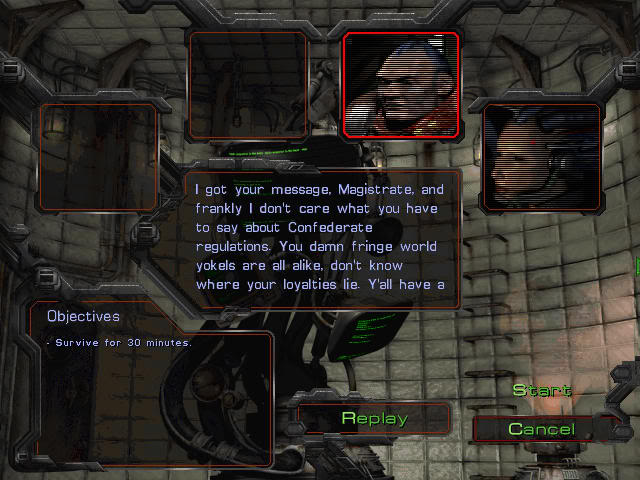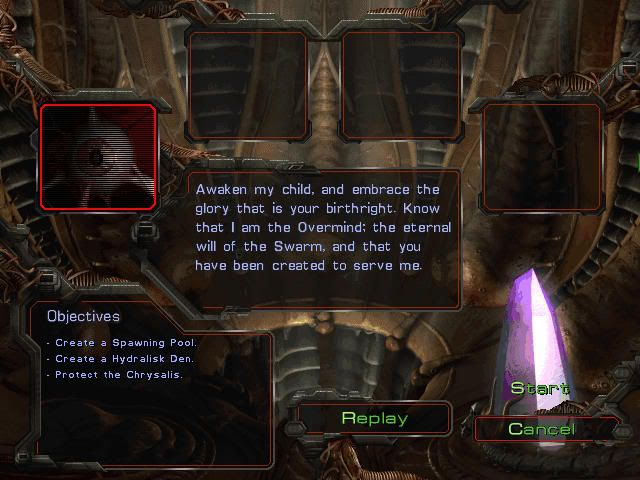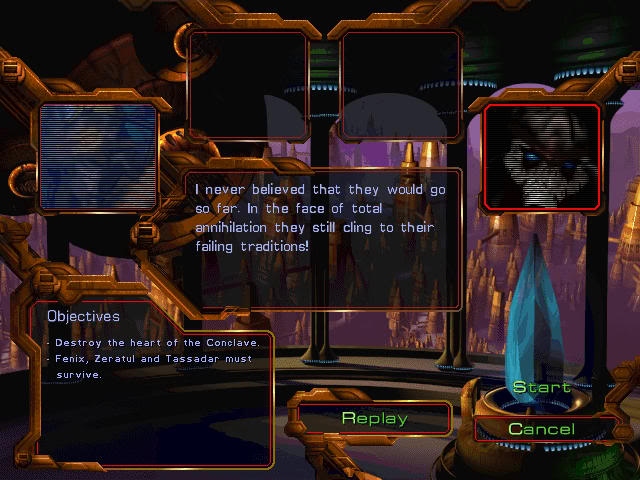This post has not been edited by the GamesBeat staff. Opinions by GamesBeat community writers do not necessarily reflect those of the staff.
What do you normally associate with the Real-Time Strategy genre of games? Probably military units, economic resources, macro and micromanagement. What about story-telling and narrative devices? Not likely, but that's understandable. The genre is well known for intense gameplay fueled by quick decision-making, but the story element in RTS games can easily lose its importance. Often, the plotline is nothing more than a clichéd skeleton used for stringing together the meaty playable missions. Besides, large-scale carnage leads to the most excitement, so why spend time negotiating with the enemy? Plot development seemingly betrays gameplay when the more exciting option is found in battle and not in communication.
Even so, not all RTS games fall prey to the gameplay/story dilemma. StarCraft, developed by Blizzard Entertainment, satisfies both sides by delivering fun gameplay alongside meaningful story sections. StarCraft deals with the inter-planetary conflict between three species: the Terrans, the Zerg, and the Protoss. The clashing of such distinct organisms makes for a bizarre war triangle, one that the user gets to experience from all sides during the three-part campaign. Each species has its own goals and reasons for warring against the galaxy, all of which seem valid while playing from that perspective.
So how does StarCraft make such good use of its story? The trick is subtlety. Written portions of StarCraft are strong enough, where needed, to properly establish an in-game universe without intruding on the action, which of course is the true focus. Looking down on the battle-scarred landscape from a bird's eye view, the player accepts the role of a military commander who must order his or her forces to scout, build, gather, and attack. The three playable races have completely different army units from one another, yet they all strive toward the same goal: victory for themselves and annihilation for anyone else.
Prior to each mission, the player is taken to a briefing screen, where allies and enemies make contact before going into battle. Like in many other videogames, the protagonist is silent throughout StarCraft, meaning other characters do all the talking while you sit back and listen. Since you have no direct influence over the conversation, the real morsels of plot and character development come from the ways in which Non-Playable Characters speak to you. Of particular importance is the name your allies call you during the briefings. Each race addresses the player in a different way, though you are doing essentially the same thing for all of them: building and managing an army. An analysis of the race-specific vocabulary provides information on the ideals, psychology, and social structure of the three species.
Terran

As the human proxy in StarCraft, Terrans relate most to our own organization, values, and emotions. The ruling force of the Terran populace is known as the Confederacy. The vast influence of the Confederacy extends to the most remote of its colonized planets, even if its sympathies do not. Terran military structure is similar to those on Earth, except on a galactic scale. Their power structure includes ranks like Generals, Colonels, and Marshals, and a top-down chain of command is readily apparent. As part of the Confederacy, the player is referred to as "Magistrate"–a word with lofty connotations that exemplify how detached the Confederacy is from its own people.
During the Terran campaign, Confederate officials give orders that endanger the lives of your entire colony. At this point, any loyalty to the Confederacy is forgotten or discarded as you try to survive relentless hostile forces without aid from central headquarters. Luckily, a splinter group called the Sons of Korhal offer to help during the alien invasion. With little choice, you accept their offer and abandon the Confederacy as a whole. You're stripped of the "Magistrate" title and are afterward more commonly referred to as "Commander" instead. Yet within the rebel alliance, human emotions such as anger, greed, and revenge run just as high. As the Korhal flag gradually gains dominance over your sector, and as their corruption grows and even surpasses that of the Confederacy, you are eventually led to break off from the so-called protectors of the people and fend for yourself. Ultimately, a Terran only cares about his or her own survival, no matter the cost.
Zerg
Unlike the Terrans, who strive for their own personal desires and individual well-being, the Zerg are a completely selfless race. The emanating power of the Zerg is known as The Overmind–an ancient super-consciousness that can create living beings through pure will. The Zerg creatures are produced from an organic mash, given flesh and sinew, and allocated a certain amount of the Overmind's attention to maintain their lifespan. Even the player character is spawned from the same process; before the initial Zerg mission, the Overmind greets you at birth and welcomes you into the Zerg Swarm. From that moment on, your purpose is to serve the Overmind in carrying its forces to victory.

The Zerg player is known as a "Cerebrate." Cerebrates are special to the Overmind, since they are given enough brainpower to think freely within the bounds of the Overmind's consciousness. All of your actions must work to the benefit of the Overmind, since your life is in its grasp; the Overmind can extinguish or reincarnate a Cerebrate as it sees fit. The word "Cerebrate" is an apt choice, since normally it is a verb meaning to think. By using it to name a specific breed of Zerg, the Overmind shows the complete mindlessness of its remaining creations. The forces that actually fight in the war are essentially servile puppets of bloodlust, so long as their master Cerebrate directs them to attack.
Protoss
Out of all three races, the Protoss are obviously the most advanced. They appear to be formed mainly out of robotic parts and sheer energy. Their society has evolved into a rigid hierarchal structure that maintains life and order. At the top of this hierarchy sits an ivory tower of Protoss elite known as the Conclave, a group of sages that direct the actions of the populace. The Protoss collective is pious and honourable, and they follow a religious caste system for distributing societal duties. For example, the player character is a Templar, whose job is to command the Conclave's army. Only Templars are allowed to direct the Protoss militia. Your Templar character is referred to as an "Executor," a name that signifies personal responsibility and obligation. Another of the Protoss castes is known as the "Judicators." The right hand of the Conclave, their duty is to ensure the safety of future Protoss and to monitor the Executors. It is common for Judicators to use the Templar caste to their own ends, with the excuse that they are acting on behalf of the Conclave.
The Protoss campaign begins in a time of turmoil. The player is replacing the previous Executor, a Templar named Tassadar, who defected from the Conclave after disobeying orders. The Zerg are approaching the Protoss home-world, and the Protoss army must be readied. Tassadar soon finds the player and relays information that can destroy the Zerg with the help of Dark Templars, a clan of expatriated Protoss now corrupted by the Overmind. Based on religious dogma, the Conclave shuns the Dark Templar, yet they are the only hope for resisting a Zerg invasion. It seems as though the old Protoss guard cannot stand at attention for much longer. Traditions must be uprooted and new measures taken to save the Protoss race.

It's my opinion that the story in StarCraft has truly underappreciated value. The writers at Blizzard prepared a fantastic script containing meticulous character development. I don't mean "character" in the individual personality sense, but in the sense that each race is a character in itself. The three races differentiate themselves in nearly every way: the architecture of their buildings, the design and look of their units, the mannerisms of their speech, and so on. Everything about them points to unlikeness rather than similarity.
Why is this noteworthy? The accentuation of differences in fact complements gameplay. Simply put, dissimilarity promotes conflict. With such incompatible organisms all pulling in opposite directions, a thrilling and dangerous struggle is bound to follow. In this way, the story lends itself to gameplay. Even though the user does not speak a word during story exposition, he or she is given the chance to communicate through actions upon the battlefield, where the fun really is.
(Originally posted on 1up.com)
